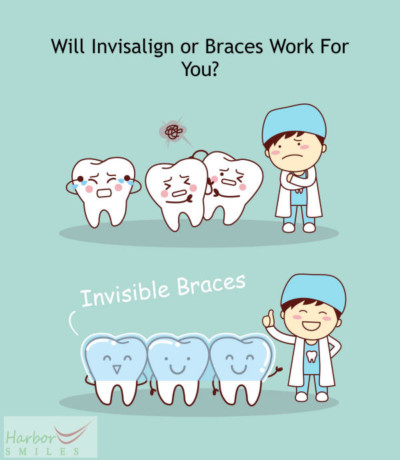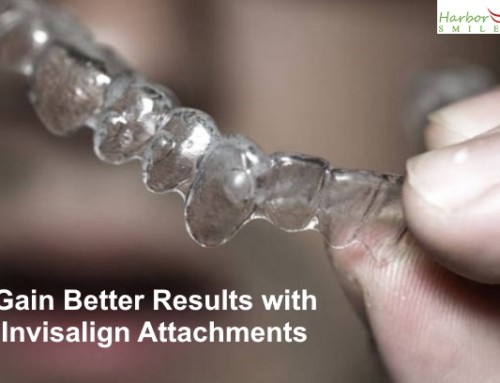 According to studies, 96 percent of people believe that their smile is crucial to their look. As a result, individuals prefer braces or Invisalign to get nicely aligned teeth.
According to studies, 96 percent of people believe that their smile is crucial to their look. As a result, individuals prefer braces or Invisalign to get nicely aligned teeth.
But, if you have to choose between Invisalign and braces, which is the best option for you?
Because the trays are tailored to each patient’s needs throughout the course of therapy, Invisalign works faster than conventional braces. Every few weeks, you’ll return to the clinic with new aligners that have been custom-made for you. As a result, most patients complete their therapy faster than they might with braces.
Comparison Between Invisalign and Braces (Traditional, Clear, Lingual)
Pros
They’re almost undetectable. When people hear about Invisalign, the first thing that comes to mind is how practically invisible these aligners are. Invisalign is a wonderful alternative to braces if you don’t like the “metal mouth” look.
With Invisalign, your teeth can be straightened without anyone even knowing about it. Movie stars, professionals, singers, and anyone who doesn’t want to draw unwanted attention can benefit from this orthodontic treatment.
There are no food or dietary limitations. You must avoid a large list of meals when wearing braces, or you could end up with a broken tooth device, delaying your orthodontic therapy. Sticky foods, for example, may easily harm your braces. There are no dietary limitations with Invisalign.
Brushing and flossing your teeth is much easier. Brushing and flossing with braces is more difficult than brushing without them, which is why most patients dislike metal or ceramic braces. There are no metal brackets or wires with Invisalign, making dental hygiene a breeze when you remove the aligners.
Fewer appointments. Braces need a lot of physical labor and upkeep, such as gluing brackets, changing wires, replacing rubber bands, and connecting springs, which may take anywhere from 20 minutes to an hour, whereas Invisalign just takes 10 minutes. Patients wearing braces need to be seen every 6 to 8 weeks, but Invisalign patients only need to be seen every 10 to 12 weeks.
There is less irritation and pain. Braces will cause mouth ulcers, pain, and discomfort until your mouth becomes used to them. Invisalign, on the other hand, does away with the pain and discomfort of brackets and wires.
Learn Reasons why Invisalign treatment is better
Cons
You must wear it for a total of 21 hours each day. When you eat or brush your teeth, you only need to remove your aligners. Treatment time will be extended if you do not wear the aligners for 21 hours per day.
It takes practice to sleep with aligners. Speaking with aligners can take a bit of practice at first, but you can adapt to it after a couple of days.
Complex tooth and bite problems may be difficult to correct.Traditional metal braces works in most cases especially complex bite and alignment cases.
Invisalign vs Braces – What is the Best Treatment For You
Invisalign retainer will be able to straighten your crooked teeth quicker than any traditional braces would as traditional braces need 18 to 24 months of treatment time while Invisalign will only take 12 to 18 months. However, the time needed to deliver the desired results depends on the complexity of your case and the treatment plan.
Is Invisalign Better Than Braces (Metal, Clear, Lingual)?
Invisalign and braces (metal or ceramic) are effective tools in straightening the teeth while improving your smile and oral health. However, Invisalign is the most preferred choice today because of how effective it is at correcting moderate tooth alignment and tooth crowding cases while traditional braces are best with severe issues.
How Expensive is Invisalign Over Braces?
The cost of braces is relatively similar to Invisalign. Metal braces are usually priced $1,800 to $6,000 while Invisalign is from $3,000 to $7,000.
Only your dental professional will know the cost of your treatment and they base that on the complexity of your case and whether metal braces or Invisalign will be used. If your teeth need more attention and work, the price is increased.
What About Lingual Braces?
Lingual braces work similarly to braces but it does that by hiding the brackets and wires on the lingual side (tongue-side) of the teeth unlike Invisalign that uses clear, removable plastic aligners.
- Lingual braces are completely hidden. The brackets are wires are hidden in plain site unlike Invisalign that shows sheen when you smile.
- These types of braces give orthodontists maximum control on the movement of your teeth. Until the end of the treatment they can make small adjustments to your teeth to achieve the desired results.
- Since the braces are fixed at the back of your teeth, you don’t have to worry about removing them when you eat.
- This treatment is suitable for everyone and they are as effective as metal braces in correcting even the most complex case of misalignment or dental crowding.
Sources:
- Ke Y, Zhu Y, Zhu M. A comparison of treatment effectiveness between clear aligner and fixed appliance therapies. BMC Oral Health. 2019;19(1):24. Published 2019 Jan 23. doi:10.1186/s12903-018-0695-z
- Frongia G, Castroflorio T. Correction of severe tooth rotations using clear aligners: a case report. Aust Orthod J. 2012 Nov;28(2):245-9. PMID: 23304975.


